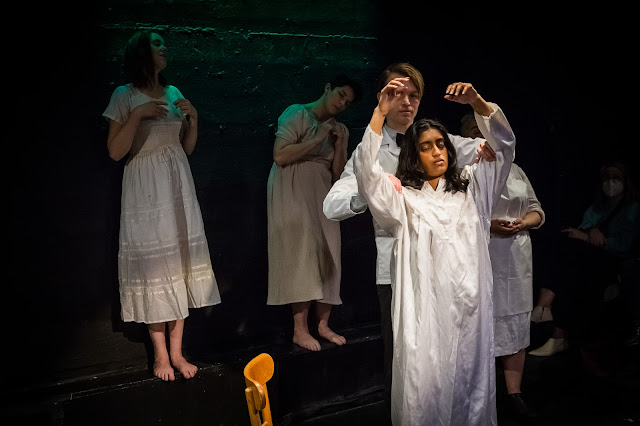#SoSadSoSexy
Written and created by Emily Cordes, Alison Leaf, and Kendra Augustin
With additional contributions by Simha Toledano and Jes Davis
Directed by Simha Toledano
312 W 36th St., Manhattan, NYC and via livestream
March 24 and 26, 2022
 |
| Front: Lucy Prescott (Uma Paranjpe) is treated by Dr. Jean-Martin Charcot (Charles Kennedy IV). Photo by Ezra Goh. |
The title of
#SoSadSoSexy, a new devised play staged by Tapestry Collective, points to a process of voyeuristic objectification: in a patriarchal culture such as ours, women's suffering, especially in connection with mental health, is aestheticized as tragically beautiful, but a woman's meeting the dominant standards of beauty is a precondition both for that sense of tragedy and for its commodification. That commodification allows our heteropatriarchal culture to distance itself from culpability by consuming in a repackaged form the very suffering to which it contributes. In the case of BIPOC women, Othering adds exoticizing wrinkles to the process. To spotlight this dynamic,
#SoSadSoSexy juxtaposes the stories of two women of color in two different centuries: Lucy Prescott (Uma Paranjpe), a student painter in nineteenth-century Paris, and, in the present day, Isabella Brooks (Jes Davis), a former child pageant reality show star who parlayed that fame into a significant social media following. A portion of the proceeds from
#SoSadSoSexy was donated to
The Loveland Foundation, which works "
to bring opportunity and healing to communities of color, and especially to Black women and girls" via fellowships, therapy support, and other programs.
 |
| Lisa (Lauren "Wren" Mitchell) and Isabella/Izzy (Jes Davis). Photo by Ezra Goh. |
Lucy begins the play under the tutelage of the artist Monsieur Boucher (Dave Rideout), who praises her talent at the same time that she worries about the fact that the marriage to which all women are destined will put an end to her time as an artist. But even the relative freedom that she possesses while unmarried can be problematic, as when a passing man asks her price, not of the painting that she is working on outdoors in the city but because he assumes that she must be a sex worker. Seventeen year-old Isabella, or Izzy, begins the play already confined to a mental health facility, having made a suicide attempt. Izzy, who remarks at one point that suicidal girls are trendy right now, does her best to keep feeding content to her fans despite the facility's regulation of phone privileges, from clandestinely shooting make-up tutorials to branding her situation with hashtags and, of course, keeping the high-angle selfies coming.
 |
| M. Boucher (Dave Rideout) and Lucy (Uma Paranjpe). Photo by Ezra Goh. |
Lucy will have her own experience with an inpatient facility, but even before that happens, a number of parallels between her and Izzy have already been established as the play shuttles back and forth between their storylines. Boucher, for example, encourages Lucy to let what troubles her manifest in her art, which raises the question of to what degree this is what Izzy's Instagram feed is doing, to what extent what she transmits to her followers is a commodified persona rather than an authentic exploration (as far as there is any such thing as an authentic self or self-presentation anyway). To take another instance, Lucy is surprised that the cabaret girls whose performances she admires must also work in brothels to make ends meet, while Izzy rebuts fellow patient Lisa's (Lauren "Wren" Mitchell) criticism of the type of content that Izzy posts with a reminder that "art" doesn't pay the bills. It is also Lisa who articulates that one must be beautiful, and read as straight, for one's suffering to rise to tragedy (or even, really, to be interesting). To highlight how far back we can trace this connection, the play invokes Shakespeare's Ophelia, and her most well-known visual representation, John Everett Millais's 1851-52 painting, certainly bears this out (Millais's painting was just a few years after Edgar Allan Poe's famous and very on-brand statement that "the death . . . of a beautiful woman is unquestionably the most poetical topic in the world," and it is reasonable to assume that Poe would extend this to include the more general suffering of a beautiful woman as well). A suffusion of paternalism provides another bridge across the centuries, whether through diagnoses such as hysteria or promises of fame as mechanisms of control; a doctor (Dave Rideout) policing Izzy's appearance (with uncomfortable implications, depending upon how one interprets his questioning); or comparisons of women to dolls, children, and fairy princesses.
 |
Cabaret performer Gabrielle (Samia Omari) and Lucy (Uma Paranjpe). Photo by Ezra Goh. |
The alternation between storylines results in some smart doubling by the cast that effectively underlines the play's themes. Charles Kennedy IV, for instance, plays both an inappropriate attendant in Izzy's facility and the abovementioned inappropriate Frenchman, while Rideout's playing both M. Boucher and Izzy's doctor, both men in positions of authority over their charges (Kennedy inhabits another important doctor, but in Lucy's narrative). Paranjpe and Davis anchor their respective narratives with aplomb, bringing a persuasive genuineness to Lucy and Izzy. Rideout lends his men of authority a nicely complicating charm, an excellent Esra Dayani creates impressively distinct characters as Izzy's mother and her nurse, and Mitchell gives a nuanced performance as Izzy's foil and friend. Presenting two complete plots, in a relatively naturalistic style, does result in a substantial running time, and the show would stand up well to just a bit of judicious trimming–particularly in the scenes following the climactic incidents of both storylines, given the extensive groundwork that has already been laid for the audience–without lessening its impact.
 |
| Izzy (Jes Davis), her mother (Esra Dayani), and her doctor (Dave Rideout). Photo by Ezra Goh. |
The play includes some instances of casual racism early, but it is the ending that really brings racialization to the fore. The often-white internet "Sad Girl" has had enough cultural presence to have been the subject of a number of think pieces and academic articles over just the past several years, and
#SoSadSoSexy demonstrates that this sort of aestheticization of women's mental health struggles, along with the controversies that surround it, is both far from new and far from exclusively white.
#SoSadSoSexy uses these observations to ask several significant questions, including: Can a woman wield power from within a cage? And, more importantly, how can she break out of it?
-John R. Ziegler and Leah Richards








Comments
Post a Comment